Impact of Ten Years Conservation Tillage in Organic Farming on Soil Physical Properties in a Loess Soil—Northern Hesse, Germany
Abstract
1. Introduction
2. Materials and Methods
2.1. Location of the Experiment
2.2. Experimental Design
2.3. Soil Physical Measurements Conducted in the LTE from 2014 to 2020
2.4. Statistical Analysis
3. Results
3.1. Bulk Density
3.2. Saturated Hydraulic Conductivity
3.3. Water-Retention Characteristics
3.4. Soil Stability
4. Discussion
Soil Compaction and Water Infiltration Capacity
5. Conclusions
Supplementary Materials
Author Contributions
Funding
Conflicts of Interest
References
- Madarász, B.; Jakab, G.; Szalai, Z.; Juhos, K.; Kotroczó, Z.; Tóth, A.; Ladányi, M. Long-term effects of conservation tillage on soil erosion in Central Europe: A random forest-based approach. Soil Tillage Res. 2021, 209, 104959. [Google Scholar] [CrossRef]
- Zikeli, S.; Gruber, S. Reduced Tillage and No-Till in Organic Farming Systems, Germany—Status Quo, Potentials and Challenges. Agriculture 2017, 7, 35. [Google Scholar] [CrossRef]
- Food and Agriculture Organization of the United Nations (FAO). Conservation Agriculture. 2022. Available online: https://www.fao.org/conservation-agriculture/en/ (accessed on 23 March 2022).
- Farooq, M.; Siddique, K.H.M. Conservation Agriculture: Concepts, Brief History, and Impacts on Agricultural Systems. In Conservation Agriculture; Farooq, M., Siddique, K.H.M., Eds.; Springer: Berlin/Heidelberg, Germany, 2015. [Google Scholar]
- Dumanski, J.; Peiretti, R. Modern concepts of soil conservation. Int. Soil Water Conserv. Res. 2013, 1, 19–23. [Google Scholar] [CrossRef]
- Mandal, A.; Dhaliwal, S.S.; Mani, P.K.; Toor, A.S. Conservation agricultural practices under organic farming. In Advances in Organic Farming; Meena, V.S., Meena, S.K., Rakshit, A., Stanley, J., Srinivasarao, C., Eds.; Elsevier: Amsterdam, The Netherlands, 2021; pp. 17–37. [Google Scholar] [CrossRef]
- Parihar, C.M.; Yadav, M.R.; Jat, S.L.; Singh, A.K.; Kumar, B.; Pradhan, S.; Chakraborty, D.; Jat, M.L.; Jat, R.K.; Saharawat, Y.S.; et al. Long term effect of conservation agriculture in maize rotations on total organic carbon, physical and biological properties of a sandy loam soil in north-western Indo-Gangetic Plains. Soil Tillage Res. 2016, 161, 116–128. [Google Scholar] [CrossRef]
- Busari, M.A.; Kukal, S.S.; Kaur, A.; Bhatt, R.; Dulazi, A.A. Conservation tillage impacts on soil, crop and the environment. Int. Soil Water Conserv. Res. 2015, 3, 119–129. [Google Scholar] [CrossRef]
- Bhattacharya, P.; Maity, P.P.; Mowrer, J.; Maity, A.; Ray, M.; Das, S.; Chakrabarti, B.; Ghosh, T.; Krishnan, P. Assessment of soil health parameters and application of the sustainability index to fields under conservation agriculture for 3, 6, and 9 years in India. Heliyon 2020, 6, e05640. [Google Scholar] [CrossRef]
- Dexter, A.R. Soil physical quality. Soil Tillage Res. 2004, 79, 129–130. [Google Scholar] [CrossRef]
- Haruna, S.I.; Anderson, S.H.; Nkongolo, N.V.; Zaibon, S. Soil Hydraulic Properties: Influence of Tillage and Cover Crops. Pedosphere 2018, 28, 430–442. [Google Scholar] [CrossRef]
- Reynolds, W.D.; Drury, C.F.; Tan, C.S.; Fox, C.A.; Yang, X.M. Use of indicators and pore volume-function characteristics to quantify soil physical quality. Geoderma 2009, 152, 252–263. [Google Scholar] [CrossRef]
- Cooper, R.J.; Hama-Aziz, Z.Q.; Hiscock, K.M.; Lovett, A.A.; Vrain, E.; Dugdale, S.J.; Sünnenberg, G.; Dockerty, T.; Hovesen, P.; Noble, L. Conservation tillage and soil health: Lessons from a 5-year UK farm trial (2013–2018). Soil Tillage Res. 2020, 202, 104648. [Google Scholar] [CrossRef]
- Ajayi, A.E.; Tassinari, D.; Araujo-Junior, C.F.; Faloye, O.T.; Abayomi, F.; Dias Junior, M.S.; Curi, N. Long-term no tillage management impact on soil hydro-physical properties in coffee cultivation. Geoderma 2021, 404, 115306. [Google Scholar] [CrossRef]
- Blanco-Canqui, H.; Ruis, S.J. No-tillage and soil physical environment. Geoderma 2018, 326, 164–200. [Google Scholar] [CrossRef]
- Steinhoff-Knopp, B.; Burkhard, B. Soil erosion by water in Northern Germany: Long-term monitoring results from Lower Saxony. CATENA 2018, 165, 299–309. [Google Scholar] [CrossRef]
- Vogeler, I.; Rogasik, J.; Funder, U.; Panten, K.; Schnug, E. Effect of tillage systems and P-fertilization on soil physical and chemical properties, crop yield and nutrient uptake. Soil Tillage Res. 2009, 103, 137–143. [Google Scholar] [CrossRef]
- Finckh, M.R.; Junge, S.M.; Schmidt, J.H.; Weedon, O.D. Disease and pest management in organic farming: A case for applied agroecology. In Burleigh Dodds Series in Agricultural Science; Köpke, U., Ed.; Burleigh Dodds Science Publishing: Cambridge, UK, 2018; pp. 271–301. [Google Scholar] [CrossRef]
- Mahanta, D.; Bisht, J.K.; Kant, L. Concept and global scenario of organic farming. In Advances in Organic Farming; Meena, V.S., Meena, S.K., Rakshit, A., Stanley, J., Srinivasarao, C., Eds.; Elsevier: Amsterdam, The Netherlands, 2021; pp. 1–16. [Google Scholar]
- Peigné, J.; Vian, J.; Payet, V.; Saby, N.P.A. Soil fertility after 10 years of conservation tillage in organic farming. Soil Tillage Res. 2018, 175, 194–204. [Google Scholar] [CrossRef]
- Casagrande, M.; Peigné, J.; Payet, V.; Mäder, P.; Sans, F.X.; Blanco-Moreno, J.M.; Antichi, D.; Bàrberi, P.; Beeckman, A.; Bigongiali, F.; et al. Organic farmers’ motivations and challenges for adopting conservation agriculture in Europe. Org. Agric. 2016, 6, 281–295. [Google Scholar] [CrossRef]
- Junge, S.M.; Storch, J.; Finckh, M.R.; Schmidt, J.H. Developing organic minimum tillage farming systems for Central and Northern European conditions. In No-till Farming Systems for Sustainable Agriculture: Challenges and Opportunities; Dang, Y.P., Dalal, R.C., Menzies, N.W., Eds.; Springer: Cham, Amsterdam, 2020; pp. 173–192. [Google Scholar] [CrossRef]
- Peigné, J.; Ball, B.C.; Roger-Estrade, J.; David, C. Is conservation tillage suitable for organic farming? A review. Soil Use Manag. 2007, 23, 129–144. [Google Scholar] [CrossRef]
- Gadermaier, F.; Berner, A.; Fließbach, A.; Friedel, J.K.; Mäder, P. Impact of reduced tillage on soil organic carbon and nutrient budgets under organic farming. Renew. Agric. Food Syst. 2012, 27, 68–80. [Google Scholar] [CrossRef]
- Peigné, J.; Casagrande, M.; Payet, V.; David, C.; Sans, F.X.; Blanco-Moreno, J.M.; Cooper, J.; Gascoyne, K.; Antichi, D.; Bàrberi, P.; et al. How organic farmers practice conservation agriculture in Europe. Renew. Agric. Food Syst. 2016, 31, 72–85. [Google Scholar] [CrossRef]
- Schmidt, J.H.; Junge, S.; Finckh, M.R. Cover crops and compost prevent weed seed bank buildup in herbicide-free wheat–potato rotations under conservation tillage. Ecol. Evol. 2019, 9, 2715–2724. [Google Scholar] [CrossRef]
- Obalum, S.E.; Uteau-Puschmann, D.; Peth, S. Reduced tillage and compost effects on soil aggregate stability of a silt-loam Luvisol using different aggregate stability tests. Soil Tillage Res. 2019, 189, 217–228. [Google Scholar] [CrossRef]
- Schmidt, J.H.; Theisgen, L.V.; Finckh, M.R.; Šišić, A. Increased resilience of peas toward root rot pathogens can be predicted by the nematode metabolic footprint. Front. Sustain. Food Syst. 2022, 6, 881520. [Google Scholar] [CrossRef]
- Schmidt, J.H.; Hallmann, J.; Finckh, M.R. Bacterivorous nematodes correlate with soil fertility and improved crop production in an organic minimum tillage system. Sustainability 2020, 12, 6730. [Google Scholar] [CrossRef]
- Eurostat. Organic Farming Statistics. 2022. Available online: https://ec.europa.eu/eurostat/statistics-explained/index.php?title=Organic_farming_statistics (accessed on 23 March 2022).
- Purnhagen, K.P.; Clemens, S.; Eriksson, D.; Fresco, L.O.; Tosun, J.; Qaim, M.; Visser, R.G.F.; Weber, A.P.M.; Wesseler, J.H.H.; Zilberman, D. Europe’s farm to fork strategy and its commitment to biotechnology and organic farming: Conflicting or complementary goals? Trends Plant Sci. 2021, 26, 600–606. [Google Scholar] [CrossRef]
- Vakali, C.; Zaller, J.G.; Köpke, U. Reduced tillage effects on soil properties and growth of cereals and associated weeds under organic farming. Soil Tillage Res. 2011, 111, 133–141. [Google Scholar] [CrossRef]
- Crittenden, S.J.; Poot, N.; Heinen, M.; van Balen, D.J.M.; Pulleman, M.M. Soil physical quality in contrasting tillage systems in organic and conventional farming. Soil Tillage Res. 2015, 154, 136–144. [Google Scholar] [CrossRef]
- Seitz, S.; Goebes, P.; Puerta, V.L.; Pereira, E.I.P.; Wittwer, R.; Six, J.; van der Heijden, M.G.A.; Scholten, T. Conservation tillage and organic farming reduce soil erosion. Agron. Sustain. Dev. 2019, 39, 4. [Google Scholar] [CrossRef]
- Kottek, M.; Grieser, J.; Beck, C.; Rudolf, B.; Rubel, F. World Map of the Köppen-Geiger climate classification updated. Meteorol. Z. 2006, 15, 259–263. [Google Scholar] [CrossRef]
- Schmidt, J.H.; Bergkvist, G.; Campiglia, E.; Radicetti, E.; Wittwer, R.A.; Finckh, M.R.; Hallmann, J. Effect of tillage, subsidiary crops and fertilisation on plant-parasitic nematodes in a range of agro-environmental conditions within Europe. Ann. Appl. Biol. 2017, 171, 477–489. [Google Scholar] [CrossRef]
- Osinaike, A. How Soil Structure and Aggregate Stability Changes with Management. Master’s Thesis, University of Kassel, Faculty of Organic Agricultural Sciences, Witzenhausen, Germany, 2017, unpublished. [Google Scholar]
- Barth, F. The Effect of Reduced Tillage and Compost Application on Soil Physical Properties of a Loess Soil in Neu-Eichenberg. Master’s Thesis, Faculty of Agricultural Sciences, Georg-August-University of Göttingen, Göttingen, Germany, 2016, unpublished. [Google Scholar]
- Rosskopf, U. Einfluss von Bodenbearbeitung und Kompostapplikation auf Stabiliät, Luftleitfähigkeit und Grobporenvolumen eines Hessischen Lössbodens. Bachelor’s Thesis, University of Kassel, Faculty of Organic Agricultural Sciences, Witzenhausen, Germany, 2016, unpublished. [Google Scholar]
- Nazari, M. Effect of Tillage and Compost on Physical Properties and Water Fluxes of a Loess Soil in Neu-Eichenberg, Germany. Master’s Thesis, University of Kassel, Faculty of Organic Agricultural Sciences, Witzenhausen, Germany, 2019, unpublished. [Google Scholar]
- Kamutzki, S. Aggregatstabilität von Ackerböden—Zusammenhänge Zwischen Makrostabilität, Mikrostabilität und der Porengrößenverteilung. Diploma Thesis, Fachbereich Ökologische Agrarwissenschaften, Witzenhausen, Germany, 2017, unpublished. [Google Scholar]
- Blume, H.P.; Brümmer, G.W.; Fleige, H.; Horn, R.; Kandeler, E.; Kögel-Knabner, I.; Kretzschmar, R.; Stahr, K.; Wilke, B.-M. Scheffer/Schachtschabel Soil Science, 1st ed.; Springer: Berlin, Germany, 2016. [Google Scholar]
- Lal, R.; Shukla, M. Principles of Soil Physics; Taylor and Francis: New York, NY, USA, 2004. [Google Scholar]
- Eijkelkamp. Hauben Water Permeameter—Operating Instructions; Eijkelkamp Agrisearch Equipment: Giesbeek, The Netherlands, 3 September 2017. [Google Scholar]
- DIN 19683-16; Soil Quality—Physical Laboratory Tests—Part 16: Determination of Aggregate Stability Using the Method of Wet Sieving. Deutsches Institut für Normung e.V.: Berlin, Germany, 2015.
- Kemper, W.D.; Rosenau, R.C. Aggregate Stability and Size Distribution. In Methods of Soil Analysis, 2nd ed.; Klute, A., Page, A.L., Eds.; American Society of Agronomy: Madison, WI, USA; Soil Science Society of America: Madison, WI, USA, 1986; pp. 425–442. [Google Scholar]
- DIN Deutsches Institut für Normung e.V. Geotechnische Erkundung und Untersuchung—Laborversuche an Bodenproben—Teil 5: Oedometerversuch mit stufenweiser Belastung CEN ISO/TS 17892-5; Beuth: Berlin, Germeny, 2004. [Google Scholar]
- Dexter, A.R.; Kroesbergen, B. Methodology for determination of tensile strength of soil aggregates. J. Agric. Eng. Res. 1985, 31, 139–147. [Google Scholar] [CrossRef]
- Mezger, T. Das Rheologie-Handbuch. Für Anwender von Rotations- und Oszillations-Rheometern, 4th ed.; Vincentz Network: Hannover, Germeny, 2010. [Google Scholar]
- Hartge, K.-H.; Horn, R. Essential Soil Physics. An Introduction to Soil Processes, Functions, Structure and Mechanics; Horten, R., Bachmann, J., Horn, R., Peth, S., Eds.; Schweizerbart’sche Verlagsbuchhandlung: Stuttgart, Germany, 2016. [Google Scholar]
- Crawley, M.J. Statistics. An Introduction Using R, 2nd ed.; Wiley: Hoboken, NJ, USA, 2014. [Google Scholar]
- Field, A.P.; Miles, J.; Field, Z. Discovering Statistics Using R; SAGE: London, UK, 2012. [Google Scholar]
- Couto, M.F.; Peternelli, L.A.; Barbosa, M.H.P. Classification of the coefficients of variation for sugarcane crops. Cienc. Rural. 2013, 43, 957–961. [Google Scholar] [CrossRef]
- AG Boden. Bodenkundliche Kartieranleitung, 5th ed.; Bundesanstalt für Geowissenschaften und Rohstoffe: Hannover, Germany, 2005. [Google Scholar]
- Ahmad, M.; Chakraborty, D.; Aggarwal, P.; Bhattacharyya, R.; Singh, R. Modelling soil water dynamics and crop water use in a soybean-wheat rotation under chisel tillage in a sandy clay loam soil. Geoderma 2018, 327, 13–24. [Google Scholar] [CrossRef]
- Schlüter, S.; Großmann, C.; Diel, J.; Wu, G.; Tischer, S.; Deubel, A.; Rücknagel, J. Long-term effects of conventional and reduced tillage on soil structure, soil ecological and soil hydraulic properties. Geoderma 2018, 332, 10–19. [Google Scholar] [CrossRef]
- Akinde, B.P.; Olakayode, A.O.; Oyedele, D.J.; Tijani, F.O. Selected physical and chemical properties of soil under different agricultural land-use types in Ile-Ife, Nigeria. Heliyon 2020, 6, e05090. [Google Scholar] [CrossRef]
- Ahuja, L.R.; Fiedler, F.; Dunn, G.H.; Benjamin, J.G.; Garrison, A. Changes in soil water retention curves due to tillage and natural reconsolidation. Soil Sci. Soc. Am. J. 1998, 62, 1228–1233. [Google Scholar] [CrossRef]
- Reichert, J.M.; Suzuki, L.E.A.S.; Reinert, D.J.; Horn, R.; Håkansson, I. Reference bulk density and critical degree-of-compactness for no-till crop production in subtropical highly weathered soils. Soil Tillage Res. 2009, 102, 242–254. [Google Scholar] [CrossRef]
- Skaalsveen, K.; Ingram, J.; Clarke, L.E. The effect of no-till farming on the soil functions of water purification and retention in north-western Europe: A literature review. Soil Tillage Res. 2019, 189, 98–109. [Google Scholar] [CrossRef]
- Blanco-Canqui, H.; Wienhold, B.J.; Jin, V.L.; Schmer, M.R.; Kibet, L.C. Long-term tillage impact on soil hydraulic properties. Soil Tillage Res. 2017, 170, 38–42. [Google Scholar] [CrossRef]
- Alfahham, A.; Amato, M.T.; Omondi, E.; Giménez, D.; Plante, A.F. Assessing the impact of organic versus conventional agricultural management on soil hydraulic properties in a long-term experiment. Soil Sci. Soc. Am. J. 2021, 85, 2135–2148. [Google Scholar] [CrossRef]
- Verhulst, N.; Govaerts, B.; Verachtert, E.; Castellanos-Navarrete, A.; Mezzalama, M.; Wall, P.; Deckers, J.; Sayre, K.D. Conservation Agriculture, improving soil quality for sustainable production systems? In Advances in Soil Science: Food Security and Soil Quality; Lal, R., Stewart, B.A., Eds.; CRC Press: Boca Raton, FL, USA, 2010; pp. 137–208. [Google Scholar]
- Fu, Y.; Tian, Z.; Amoozegar, A.; Heitman, J. Measuring dynamic changes of soil porosity during compaction. Soil Tillage Res. 2019, 193, 114121. [Google Scholar] [CrossRef]
- Indoria, A.K.; Rao, S.; Sharma, K.L.; Sammi Reddy, K. Conservation Agriculture—A Panacea to Improve Soil Physical Health. Curr. Sci. 2017, 112, 52. [Google Scholar] [CrossRef]
- Palm, C.; Blanco-Canqui, H.; DeClerck, F.; Gatere, L.; Grace, P. Conservation agriculture and ecosystem services: An overview. Agric. Ecosyst. Environ. 2014, 187, 87–105. [Google Scholar] [CrossRef]
- Weedon, O.D.; Finckh, M.R. Response of wheat composite cross populations to disease and climate variation over 13 generations. Front. Agric. Sci. Eng. 2021, 8, 400–415. [Google Scholar]
- Junge, S.; Finckh, M.R. Biokartoffeln pfluglos anbauen. Lumbrico 2020, 2020, 37–41. [Google Scholar]
- Lamandé, M.; Schjønning, P.; Labouriau, R. A novel method for estimating soil precompression stress from uniaxial confined compression tests. Soil Sci. Soc. Am. J. 2017, 81, 1005–1013. [Google Scholar] [CrossRef]
- Farooq, M.; Siddique, K.H.M. Conservation Agriculture; Springer International Publishing: Berlin/Heidelberg, Germany, 2015. [Google Scholar]
- Chellappa, J.; Sagar, K.L.; Sekaran, U.; Kumar, S.; Sharma, P. Soil organic carbon, aggregate stability and biochemical activity under tilled and no-tilled agroecosystems. J. Agric. Food Res. 2021, 4, 100139. [Google Scholar] [CrossRef]
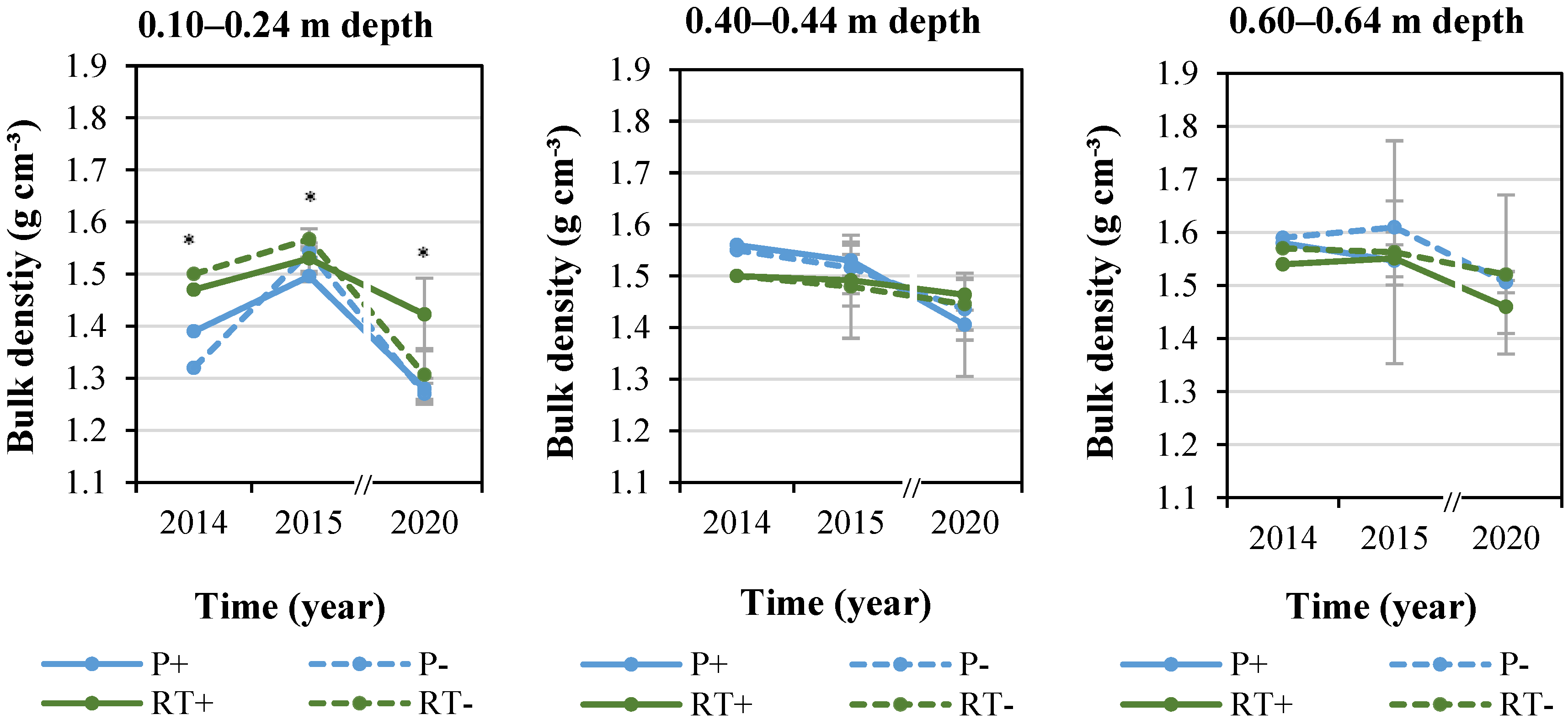
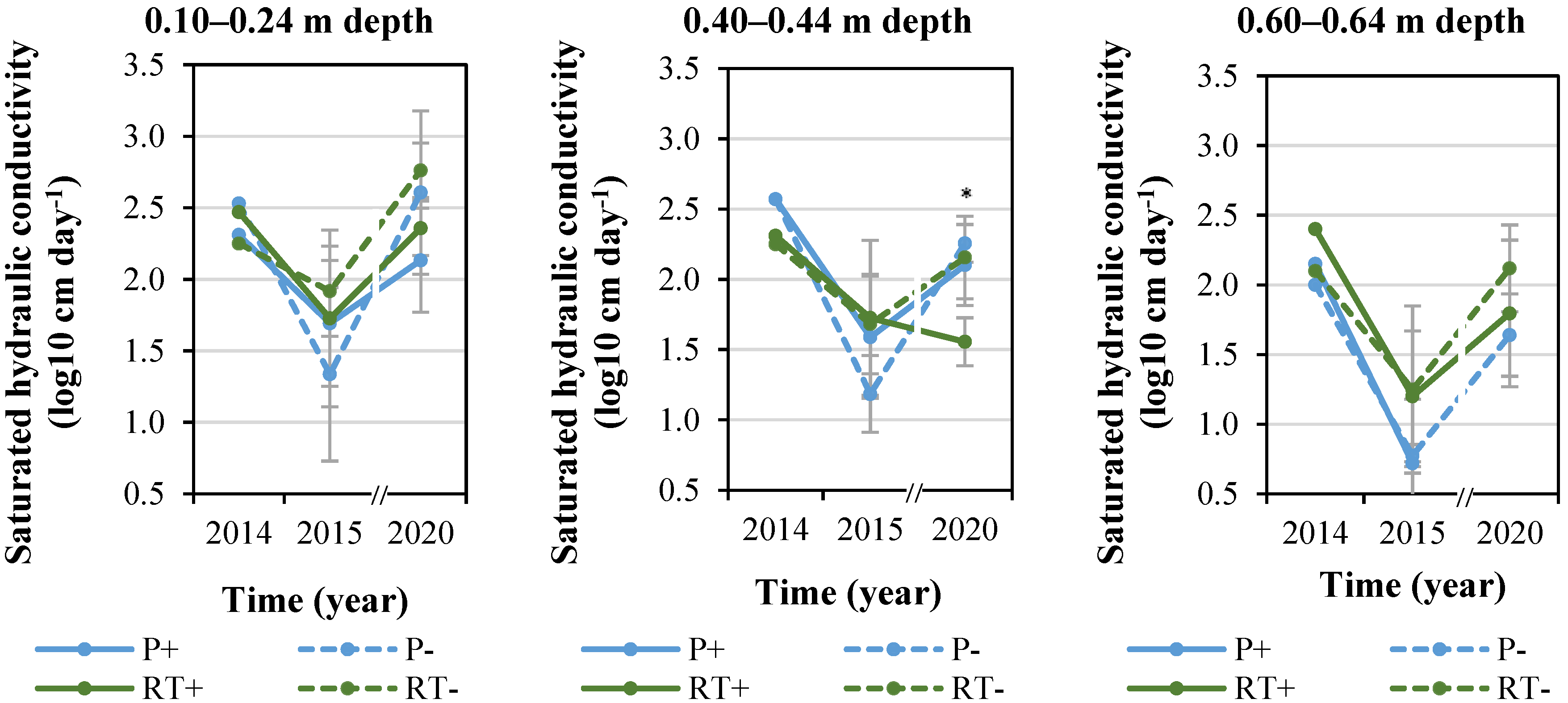
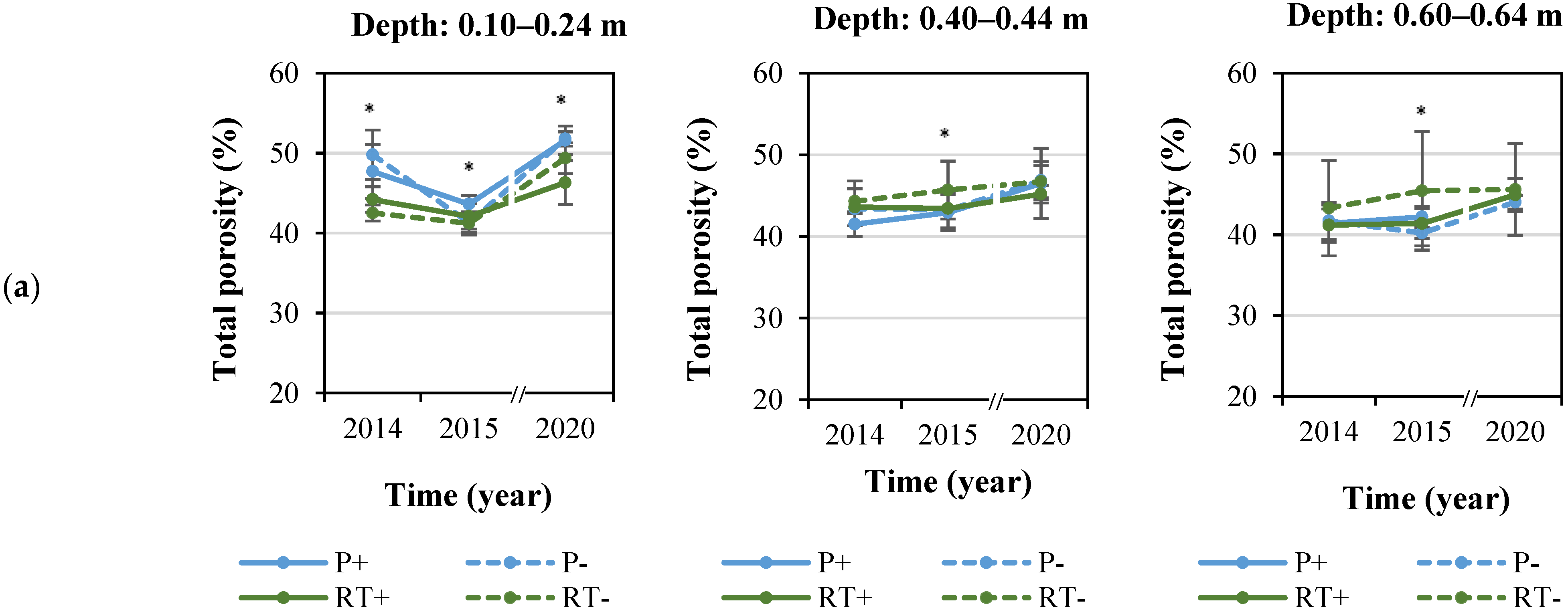
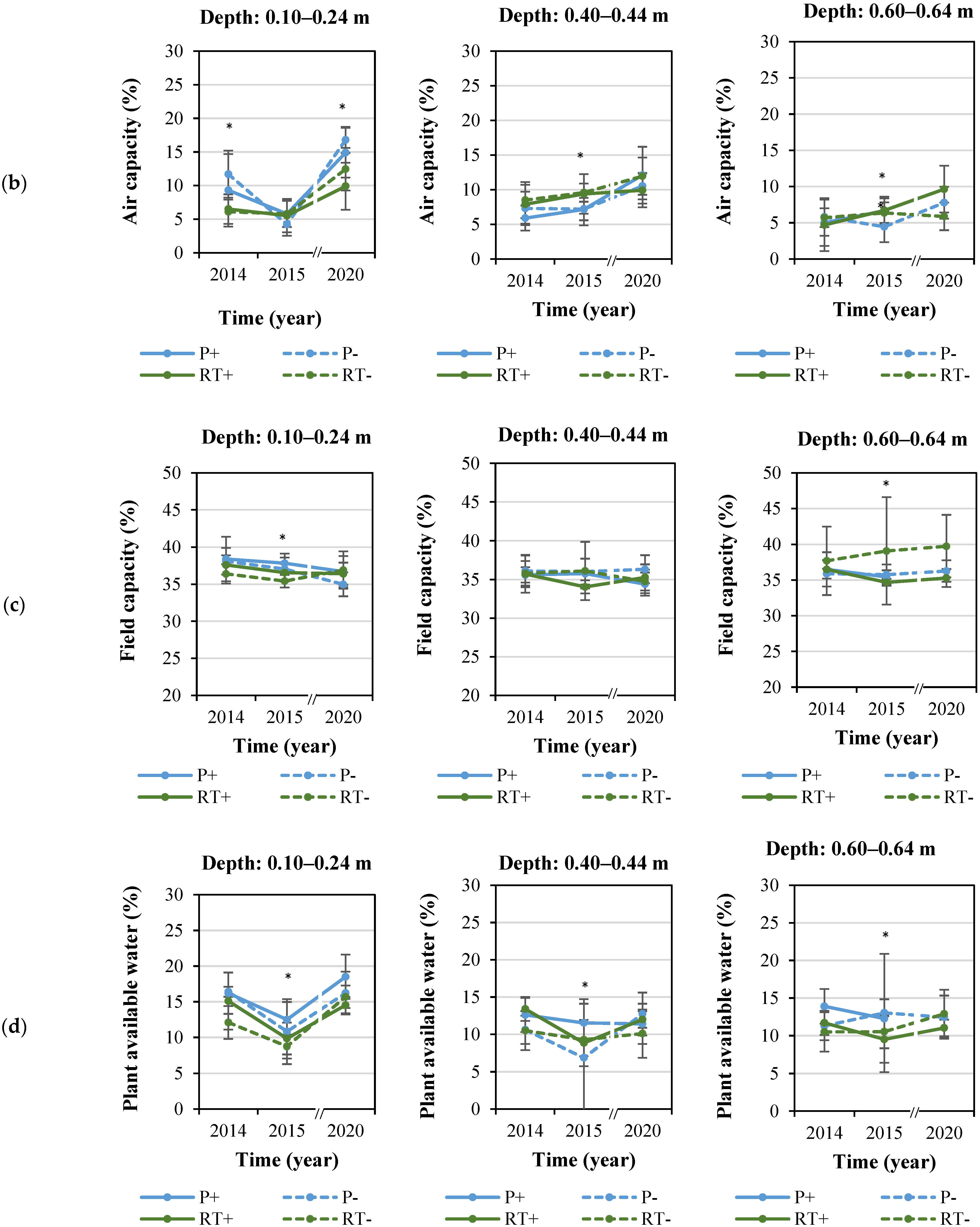
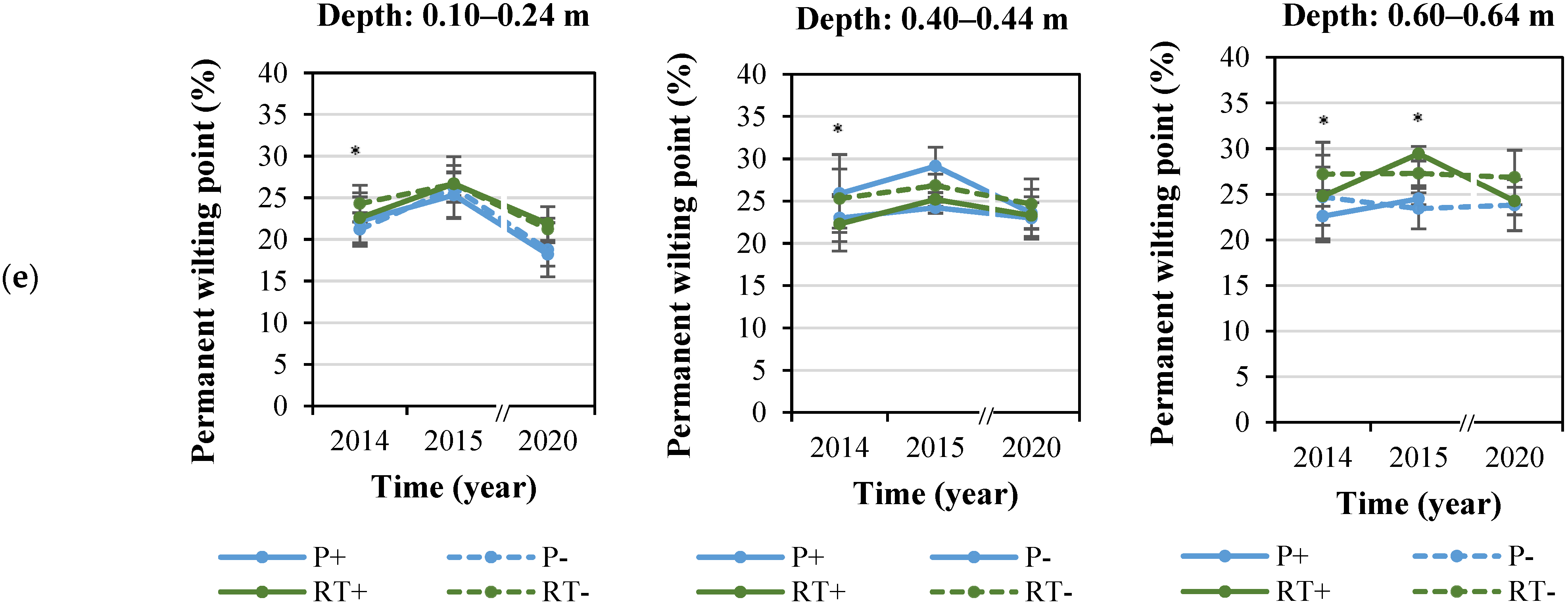
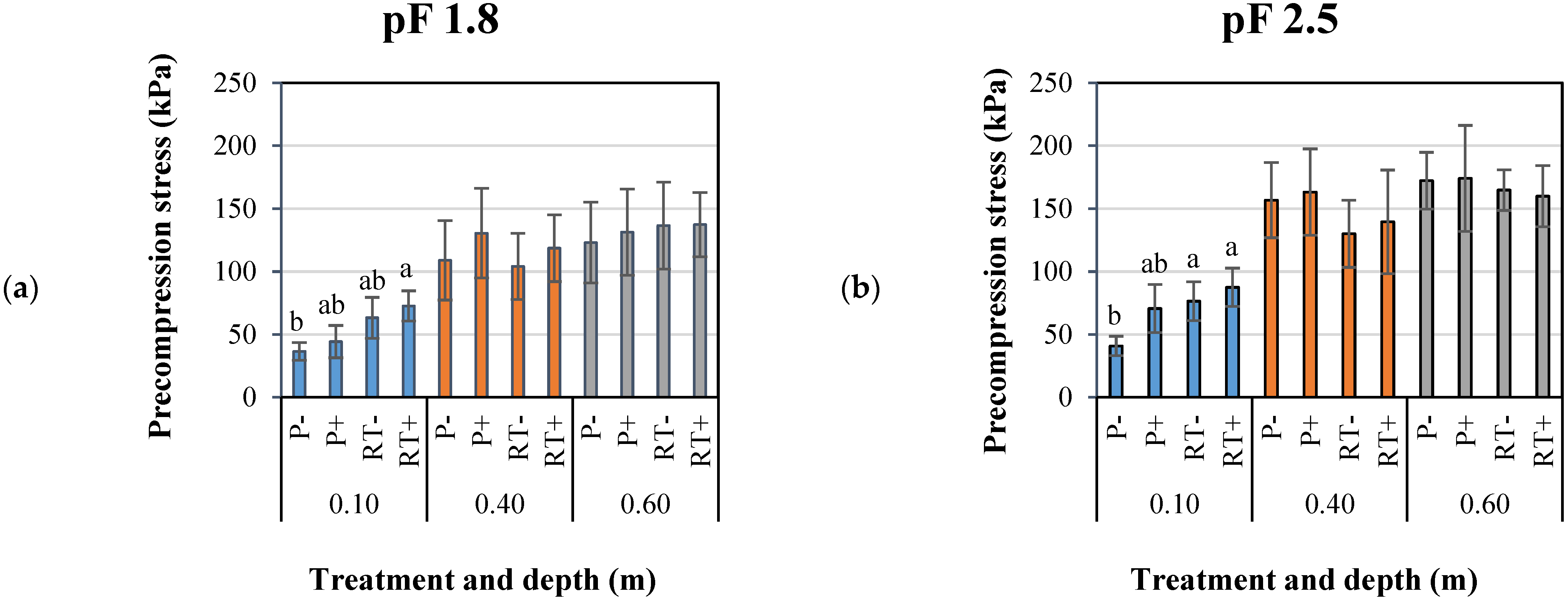
| Sampling Depth (m) | Sampling Date (Month/Year) | ρb | Ksat | SWC | Soil Stability | |||
|---|---|---|---|---|---|---|---|---|
| Precompression Stress | Wet Sieving | Tensile Strength | Shear Stress | |||||
| 0.05–0.10 | 3/2014 1 | x | ||||||
| 0.10–0.14, 0.40–0.44; 0.60–0.64 | 3/2014 2,3 | x2 | x2 | x2 | x3 | |||
| 0.20–0.24, 0.40–0.44, 0.60–0.64; 1.00–1.04 | 9/2015 4 | x | x | x | ||||
| 0–0.05 | 10/2016 5 | x | x | |||||
| 0.03–0.07, 0.15–0.19, 0.40–0.44; 0.60–0.64 | 5 and 7/2020 6 | x | x | x | x | |||
Disclaimer/Publisher’s Note: The statements, opinions and data contained in all publications are solely those of the individual author(s) and contributor(s) and not of MDPI and/or the editor(s). MDPI and/or the editor(s) disclaim responsibility for any injury to people or property resulting from any ideas, methods, instructions or products referred to in the content. |
© 2023 by the authors. Licensee MDPI, Basel, Switzerland. This article is an open access article distributed under the terms and conditions of the Creative Commons Attribution (CC BY) license (https://creativecommons.org/licenses/by/4.0/).
Share and Cite
Bilibio, C.; Uteau, D.; Horvat, M.; Rosskopf, U.; Junge, S.M.; Finckh, M.R.; Peth, S. Impact of Ten Years Conservation Tillage in Organic Farming on Soil Physical Properties in a Loess Soil—Northern Hesse, Germany. Agriculture 2023, 13, 133. https://doi.org/10.3390/agriculture13010133
Bilibio C, Uteau D, Horvat M, Rosskopf U, Junge SM, Finckh MR, Peth S. Impact of Ten Years Conservation Tillage in Organic Farming on Soil Physical Properties in a Loess Soil—Northern Hesse, Germany. Agriculture. 2023; 13(1):133. https://doi.org/10.3390/agriculture13010133
Chicago/Turabian StyleBilibio, Carolina, Daniel Uteau, Malte Horvat, Ulla Rosskopf, Stephan Martin Junge, Maria Renate Finckh, and Stephan Peth. 2023. "Impact of Ten Years Conservation Tillage in Organic Farming on Soil Physical Properties in a Loess Soil—Northern Hesse, Germany" Agriculture 13, no. 1: 133. https://doi.org/10.3390/agriculture13010133
APA StyleBilibio, C., Uteau, D., Horvat, M., Rosskopf, U., Junge, S. M., Finckh, M. R., & Peth, S. (2023). Impact of Ten Years Conservation Tillage in Organic Farming on Soil Physical Properties in a Loess Soil—Northern Hesse, Germany. Agriculture, 13(1), 133. https://doi.org/10.3390/agriculture13010133






